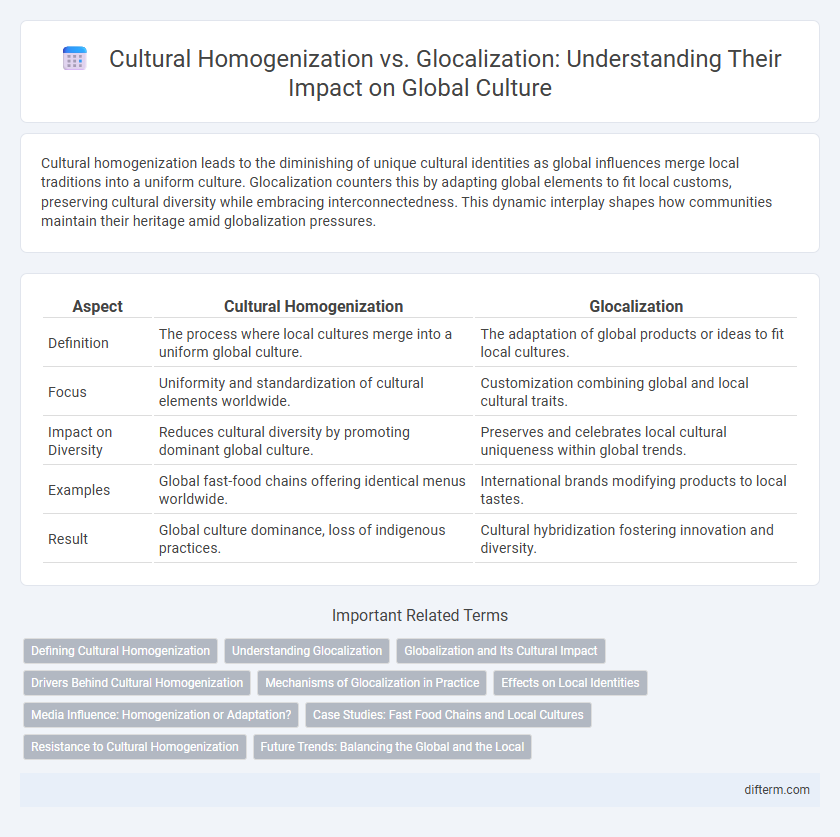Cultural homogenization leads to the diminishing of unique cultural identities as global influences merge local traditions into a uniform culture. Glocalization counters this by adapting global elements to fit local customs, preserving cultural diversity while embracing interconnectedness. This dynamic interplay shapes how communities maintain their heritage amid globalization pressures.
Table of Comparison
| Aspect | Cultural Homogenization | Glocalization |
|---|---|---|
| Definition | The process where local cultures merge into a uniform global culture. | The adaptation of global products or ideas to fit local cultures. |
| Focus | Uniformity and standardization of cultural elements worldwide. | Customization combining global and local cultural traits. |
| Impact on Diversity | Reduces cultural diversity by promoting dominant global culture. | Preserves and celebrates local cultural uniqueness within global trends. |
| Examples | Global fast-food chains offering identical menus worldwide. | International brands modifying products to local tastes. |
| Result | Global culture dominance, loss of indigenous practices. | Cultural hybridization fostering innovation and diversity. |
Defining Cultural Homogenization
Cultural homogenization refers to the process by which local cultures are transformed or absorbed by dominant external cultures, leading to a reduction in cultural diversity worldwide. This phenomenon often results from globalization, where multinational corporations, international media, and global communication platforms propagate uniform cultural products, values, and practices. The consequence is the erosion of unique cultural identities, traditions, and languages, creating a more standardized and less varied global cultural landscape.
Understanding Glocalization
Glocalization represents the adaptation of global ideas and products to fit local cultures, preserving unique traditions while embracing global trends. This process counters cultural homogenization by allowing diverse communities to maintain their identity amid globalization. Companies and societies leverage glocalization to balance global connectivity with cultural specificity, fostering innovation and cultural resilience.
Globalization and Its Cultural Impact
Globalization drives cultural homogenization by spreading dominant cultural traits, often leading to the erosion of local traditions and identities. However, glocalization emerges as a counterbalance, enabling communities to adapt global influences to fit their unique cultural contexts, preserving diversity while embracing modernity. This dynamic interaction highlights the complex cultural impact of globalization, where global connectivity coexists with localized cultural expression.
Drivers Behind Cultural Homogenization
Globalization, technological advancements, and multinational corporations drive cultural homogenization by promoting standardized products, media, and lifestyles across diverse societies. Mass media and digital platforms disseminate dominant cultural norms, diminishing local traditions and languages. Economic incentives for uniformity also encourage cultural convergence, often prioritizing global consumer markets over cultural uniqueness.
Mechanisms of Glocalization in Practice
Glocalization operates through mechanisms such as adaptive product modification, localized marketing strategies, and incorporation of indigenous cultural elements to meet specific community needs. Multinational corporations often collaborate with local stakeholders to blend global brand identity with regional traditions, fostering cultural resonance and consumer acceptance. This dynamic process preserves cultural diversity while enabling global connectivity and economic integration.
Effects on Local Identities
Cultural homogenization leads to the erosion of unique local identities as global cultural elements overshadow indigenous traditions, languages, and customs. Glocalization, however, enables communities to adapt global influences while preserving and reinventing their cultural distinctiveness, fostering a dynamic interplay between global and local elements. This process strengthens local identities by promoting cultural diversity and resilience amid globalization pressures.
Media Influence: Homogenization or Adaptation?
Media plays a pivotal role in shaping cultural landscapes by either promoting cultural homogenization or fostering glocalization through adaptation. Global media conglomerates often standardize content, risking the erosion of local traditions and identities, yet localized adaptations within media formats enable cultures to retain distinctiveness while engaging broader audiences. The tension between uniform media narratives and culturally tailored content underscores the dynamic interaction between global influence and local cultural resilience.
Case Studies: Fast Food Chains and Local Cultures
Fast food chains such as McDonald's and KFC serve as prime examples of cultural homogenization, spreading standardized menus and global branding that often overshadow local culinary traditions. However, these brands frequently adopt glocalization strategies by incorporating local flavors and ingredients--like McDonald's Teriyaki Burger in Japan or KFC's Spicy Paneer in India--thereby respecting and integrating regional cultural identities. This blending showcases how multinational fast food companies balance global uniformity with local cultural nuances to appeal to diverse markets.
Resistance to Cultural Homogenization
Resistance to cultural homogenization manifests through the preservation of indigenous languages, traditional practices, and local customs that assert distinct identities against global cultural dominance. Communities employ glocalization by adapting global influences to fit local contexts, creating hybrid cultural expressions that reinforce uniqueness while engaging with modernity. This dynamic interplay sustains cultural diversity and challenges the erasure of localized heritage in an increasingly interconnected world.
Future Trends: Balancing the Global and the Local
Future trends in cultural dynamics emphasize balancing global influences with local traditions through glocalization, enabling communities to adapt global products and ideas while preserving unique identities. Cultural homogenization faces resistance as technology fosters niche markets and localized content, promoting diversity within globalization. This equilibrium supports sustainable cultural development by integrating innovation with heritage conservation.
Cultural Homogenization vs Glocalization Infographic

 difterm.com
difterm.com